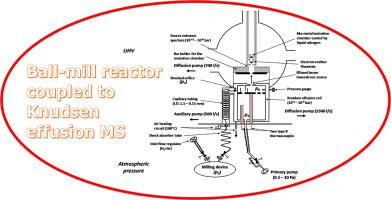International Journal of Hydrogen Energy ( IF 8.1 ) Pub Date : 2020-11-24 , DOI: 10.1016/j.ijhydene.2020.10.241 A. El Kharbachi , I. Nuta , L. Artaud , H. Collas , C. Chatillon

|
Identification of species in the gaseous phase of hydride materials and their mixtures (e.g. LiBH4–MgH2) is crucial for understanding the reactional mechanisms and diffusion kinetics of hydrogen across the different interfaces of phase segregation. This phase separation makes the characterization by conventional gas analysis techniques complicated and some analytical information could not be accessible. To overcome this surface/interface related issue, the study of the evolution of the gas phase emitted by the complex hydrides during ball-milling is considered. In this respect, an experimental set-up is designed by coupling a milling reactor with a mass spectrometer through a capillary tubing and an effusion Knudsen cell. A gas flow study (from molecular to viscous regimes) is performed in order to propose a suitable architecture of the entire device (ball-mill, capillary tubing, pipes, effusion cell compartment and pumping system) compatible with the mass spectrometric detection in terms of effused flow and molecular beam. Simulation of the flows and definition of their regimes nature at each stage of the pipes and vessels system is addressed as function of geometric parameters, upstream pressures, and pumping capacity on the downstream side (effusion cell). The study highlights the advantage of using a capillary tubing for the connection and ensure an optimal detection. Different working pressure conditions are demonstrated and associated to its length, meanwhile the diameter of the capillary has been demonstrated to be too sensitive to be varied.
中文翻译:

铣削反应器与高温质谱仪耦合的设计,用于氢基材料的热力学/动力学数据1
鉴定氢化物材料及其混合物的气相中的物质(例如,LiBH 4 –MgH 2)对于理解氢在相分离不同界面上的反应机理和扩散动力学至关重要。这种相分离使得通过常规气体分析技术的表征变得复杂,并且一些分析信息无法获得。为了克服与表面/界面有关的问题,考虑了球磨过程中由复合氢化物释放出的气相的演变的研究。在这方面,通过将研磨反应器与质谱仪通过毛细管和积液努氏池耦合,设计了实验装置。进行了气流研究(从分子态到粘性态),以提出整个设备(球磨机,毛细管,管道,积液室和泵送系统)在积液流和分子束方面与质谱检测兼容。根据几何参数,上游压力和下游侧(积液池)的泵送能力的函数,对管道和容器系统各阶段的流量模拟及其状态的定义进行了讨论。该研究强调了使用毛细管进行连接并确保最佳检测的优势。证明了不同的工作压力条件并与它的长度相关联,同时,已经证明毛细管的直径过于敏感而无法变化。根据几何参数,上游压力和下游侧(积液池)的泵送能力的函数,对管道和容器系统各阶段的流量模拟及其状态的定义进行了讨论。该研究强调了使用毛细管进行连接并确保最佳检测的优势。证明了不同的工作压力条件并与它的长度相关联,同时,已经证明毛细管的直径过于敏感而无法变化。根据几何参数,上游压力和下游侧(积液池)的泵送能力的函数,对管道和容器系统各阶段的流量模拟及其状态的定义进行了讨论。该研究强调了使用毛细管进行连接并确保最佳检测的优势。证明了不同的工作压力条件并与它的长度相关联,同时,已经证明毛细管的直径过于敏感而无法变化。











































 京公网安备 11010802027423号
京公网安备 11010802027423号